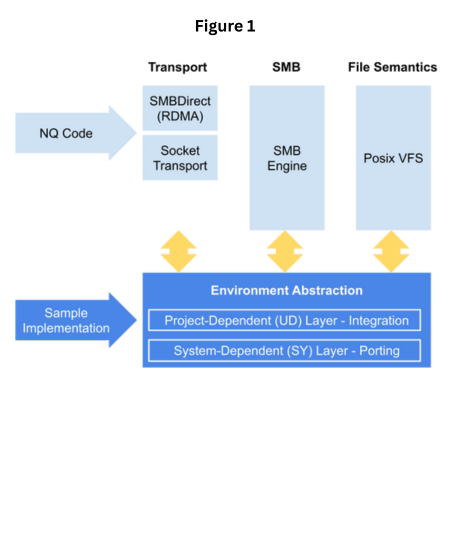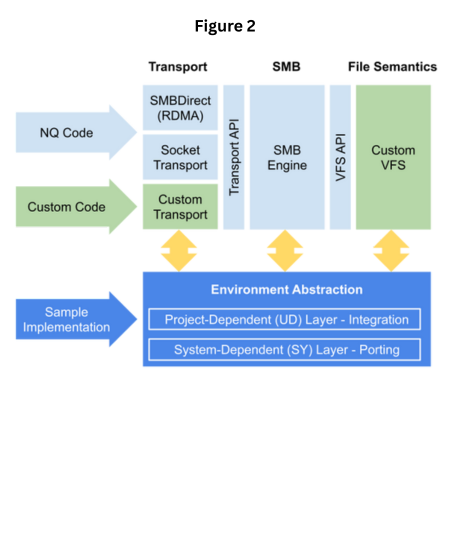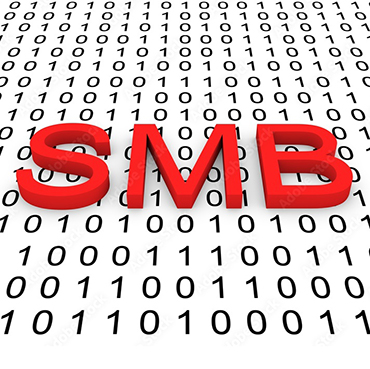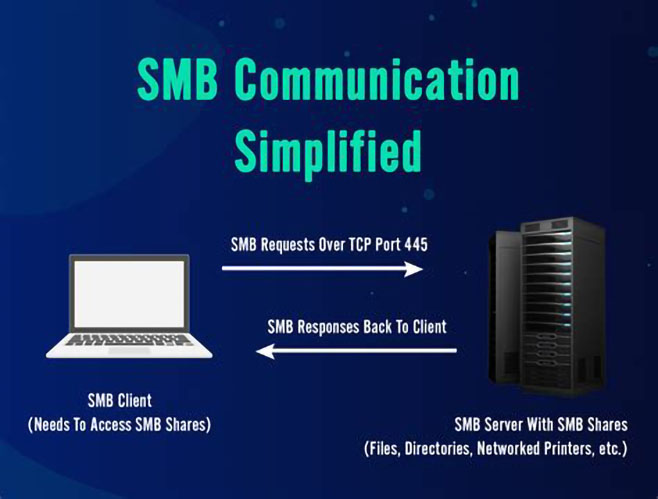The SMB Protocol Engine for Scalable Storage Solutions
NQ Storage is a powerful SMB3 server designed for seamless integration into storage systems, from standalone NAS to enterprise-scale clustered environments. Offered as source code for independent development, it provides a robust foundation for organizations building their own SMB-based storage solutions.
NQ Storage features a thread-based implementation that is designed for efficiency and scalability. This architecture enables efficient handling of thousands of client connections, large-scale file operations, and demanding workloads while maintaining low resource consumption.
NQ Storage supports all SMB dialects up to the latest 3.1.1, ensuring interoperability with any SMB client. With expert consulting services available, Visuality Systems helps organizations integrate SMB into their storage infrastructure efficiently and affordably.
What Makes
NQ Storage Unique?
With expert consulting from Visuality Systems, NQ Storage is an affordable SMB solution for organizations developing their own storage systems or upgrading existing infrastructure.
NQ Storage is architected for integration into a wide range of storage solutions — from ready-to-run on standalone Linux systems to more advanced clustered deployments requiring a custom VFS implementation. Its modular architecture, object-oriented design, and project-dependent layer allow organizations to tailor SMB connectivity to their specific storage needs while keeping costs under control. It features a pluggable transport module, enabling custom networking solutions beyond standard sockets.
NQ Storage fully supports SMB2, SMB3, and SMB3.1.1, ensuring seamless compatibility with any SMB client. It implements key SMB protocol features such as Multi-Channel for improved performance and Shadow Copy for efficient backup and recovery. NQ Storage also supports SMB Direct (RDMA) and QUIC, offering advanced transport options for high-speed and secure data transfer. Additionally, it is optimized for workloads that rely on SMB, including Microsoft SQL Server and Hyper-V, ensuring smooth integration in enterprise environments.
With a multi-threaded architecture, NQ Storage efficiently handles large volumes of file operations. It leverages epoll-based message handling, prioritized I/O operations, and a dedicated VFS layer to maximize responsiveness. Zero-copy data handling (IOVEC) further enhances throughput, making it ideal for demanding applications like virtualized environments and high-speed storage networks.
NQ Storage is optimized for large-scale environments, successfully tested under extreme loads with up to 10,000 concurrent connections performing intensive I/O operations. Its thread-pool mechanism ensures efficient connection management, while configurable internal databases allow fine-tuned memory allocation for optimal performance.
NQ Storage offers intuitive runtime control, allowing dynamic management of SMB shares, user access, and service configurations without downtime. Administrators can easily add or remove users, modify shares, and restart or terminate services as needed.
NQ Storage integrates seamlessly with Active Directory for secure domain authentication, enabling passthrough authentication and fine-grained access control. Its built-in Security Descriptor library provides robust user permission management, ensuring compliance with enterprise security policies.
Want to learn more?
NQ Storage: A Flexible SMB Stack for Standalone and Clustered Storage Solutions
NQ Storage is a highly portable, modular SMB stack designed for seamless integration into storage solutions – delivering enterprise-grade functionality with a significantly lower total cost of ownership compared to existing alternatives. It serves as the foundation for both standalone and clustered storage architectures, allowing organizations to build customized SMB-based file services.
Core Architecture (Common to Both Configurations)
NQ Storage’s design ensures consistency and flexibility across deployments, with the following core components:
- Transport Module – Supports multiple networking options, including Socket Transport and SMB Direct (RDMA), with an extensible interface for custom implementations such as QUIC.
-
SMB Engine – Implements the full SMB2, SMB3, and SMB 3.1.1 protocol stack, enabling enterprise-grade file sharing.
-
System-Dependent (SY) Layer – A sample implementation provided for porting NQ Storage to different operating systems.
-
Project-Dependent (UD) Layer – A sample implementation that serves as a foundation for integration into custom storage solutions.
- Transport Module – Supports multiple networking options, including Socket Transport and SMB Direct (RDMA), with an extensible interface for custom implementations such as QUIC.
- SMB Engine – Implements the full SMB2, SMB3, and SMB 3.1.1 protocol stack, enabling enterprise-grade file sharing.
- System-Dependent (SY) Layer – A sample implementation provided for porting NQ Storage to different operating systems.
- Project-Dependent (UD) Layer – A sample implementation that serves as a foundation for integration into custom storage solutions.
Standalone SMB Server Deployment
When deployed as a standalone, ready-to-use SMB server, NQ Storage operates with a modular architecture, illustrated in Figure 1, that includes:
- Built-in socket-based networking for standard connectivity.
- A sample POSIX VFS implementation, immediately deployable on Linux, that manages file system semantics.
This architecture ensures high performance, minimal CPU overhead, and efficient SMB traffic handling, with QUIC offering an additional transport option for secure, firewall-friendly communication.

Clustered Storage Integration
For organizations implementing clustered storage solutions, NQ Storage can be integrated as a high-performance SMB front-end. This architecture, shown in Figure 2, is equipped with:
- Support for custom transport implementations, to optimize performance. Also, QUIC can further enhance multi-node communication by reducing handshake overhead and improving data transfer efficiency over UDP.
- Persistent Handles, Continuously Available Shares, and other multi-node features are handled at the storage system level.
- File system semantics span multiple nodes, requiring a custom VFS implementation instead of the provided sample POSIX VFS module.
- NQ Storage’s well-defined VFS API allows seamless integration with an existing cluster-aware file system.
- The asynchronous callback-driven VFS API enables maximum efficiency in multi-threaded environments, optimizing performance for high-throughput workloads.
Backed by Visuality Systems’ expertise, organizations can leverage NQ Storage to develop tailored SMB-based storage solutions without a heavy financial burden.

and approved
evaluation
by your team
Visuality systems
support & guidance
Visuality Systems
maintenance & support
What sets Visuality System apart?
Related resources
Visuality NQ Storage solution – Stephen Foskett and a panel of Storage Field Day delegates (Webinar)
Upgrade Your Product
Upgrade your SMB today with a fully scalable, robust, and continually updated SMB client library with 24/7 dedicated, rapid response support.




